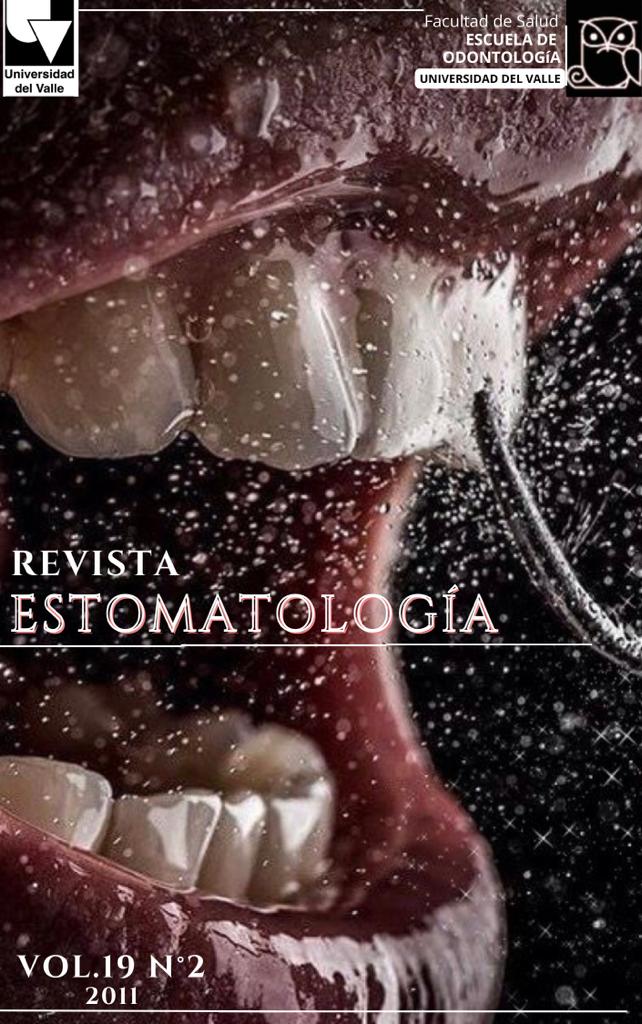Changes in the gingival margin after crown lengthening in patients with altered passive dental eruption type IB
Main Article Content
Objectives: The purpose of this descriptive investigation is to evaluate the changes in the dental high 3 months after surgery including the more frequent complications after in patients with passive altered eruption type IB.
Materials and methods: This study evaluated 20 patients with altered passive eruption type IB classified into group I (central incisors, lateral and canine 14 cases) and group II (first premolar, second premolar and first molar 6 cases), who have performed crown lengthening and assessed the change in tooth size before surgery, in the immediate postoperative and 3 months after surgery for each type of tooth.
Results:It was found that gingival crown migration to central incisors and canines (group I) and first and second premolars (group II) was approximately 1 mm, for the first molar (group II) was of 0.65mm and 1.85mm lateral incisors being the tooth with more gingival regrowth. Postsurgical complications evaluated were the presence of extraoral swelling was higher in the cases in group I (60%), papillary and marginal inflammation mild (20%), moderate (50%) and severe (30%) of cases which was always higher in group I. Postsurgical pain was found in 80% of patients (16) patients which commonly was mild (60%) to moderate (40%). Only one case showed postsurgical bleeding (5%).
Conclusions: After making a crown length surgery in patients with passive altered eruption there is a coronal migration of the gingiva in all teeth being bigger in the lateral incisor. The listed complications are : extraoral edema, pain and papillary inflammation.
Key words: Crown Length, periodontal surgery, gingival margin, passive altered eruption 1B, periodontal surgery complications.
2. Orban B. Dimensions and relations of the dentogingival junction in humans. J Periodontol 1961; 32:261-7.
3. Gottlieb B, Orban B. Active and passive continuous eruptions of teeth. J Dent Res. 1933; 13:214-8.
4. Mason J. Passive eruption. Dent Pract Dent Rec 1963; 14:2-9.
5. Giargiulo T, Wentz, Orban B. Dimensions and Relations of the Dentogingival Junctions in Humans. Journal of Periodontology 1961; 32:261-7.
6. Ingbar R, Coslet JG. The Biologic Width. A Concept in Periodontics and Restorative Dentistry: Alpha Omegan 1997; 10:62-65.
7. Weinberg MA, Fernández MA, Sherer W. La erupción pasiva alterada: un antiguo concepto con un enfoque diferente. Journal de Clínica en Odontología 1998; 3:13-7.
8. Ainamo J , LoeH. Anatomical characteristics of gingival. A clinical and microscopic study of the free and attached gingival. Journal of Periodontology 1966; 37:5-13.
9. Lombardi R. The principles of visual perception and their clinical application to denture esthetics. Journal of Prosthetic Dentistry 1973; 29:358-82.
10. Evian C, Cutler S. Altered passive eruption. The undiagnosed entity. JADA 1993; 10:107-10.
11. Coslet J, Vandarsall R, Weigold A. Diagnosis and classification of delayed passive eruption of the dentogingival junction in the adult. Alpha Omegan 1977;70:24-8.
12. Allen E. Surgical crown lengthening for function and esthetics. Dent Clin North Am 1993; 37:163-79.
13. Calsina G. Cirugía pre-protésica. Alargamiento de corona clínica. SEPA. Periodoncia 1991; 1:35-25.
14. Keough B. Periodontal prótesis. Prosthetic management for patients with advanced periodontal disease.
En: Clark JW (Ed). Clinical Dentistry Philadelphia: JB Lippincoll, 1981.
15. Escobar F. Odontología pediátrica. Amolda 2004; 89-91.
16. Mout, G. Glass ionomer cements and future research. Am J Dent 1994; 7: 286-292.
17. Goldman, Cohen, Genco. Periodoncia. Interamericana Mc Graw-Hill; 1993:597- 600.
18. Volchansky, A., CLeaton, Jones. Delayed passive eruption a predisposicing factor Vincent’s infection. JADA 1974; 12:291-4.
19. Feinman, K. The high lip line. A practical approach. California Dent Assoc J. 1992; 20:23-5.
20. Swenson HM, HansenNM.Th e periodontist and cosmetic dentistry. Journal Of Periodontology 1961; 32:824.
21. Hempton TJ, Esrason, F. Crown lengthening to facilitate restorative treatment in the presence of incomplete passive eruption. Journal of the Massachusetts Dental Society 1999; 47(4):17-22.
22. Garber DA. Salama MA. The esthetic smi l e : di agnos i s and t r e a tment . Periodontology 2000 1996; 11:18-28.
23. Fernandez R., Arias J, Simonneau EG. Erupción pasiva alterada. Repercusiones en la estética dentofacial.
RCOE 2005; 10:289-302.
24. Ferro MB, Gómez M. Periodoncia. Fundamentos de la Odontología. Facultad de Odontología. Pontificia Universidad Javeriana. Primera Edición. Bogota 2000. 400-409.
25. Jorgensen MG, Nowzari H. Aesthetic crown lengthening. Periodontology 2000. 2001; 27:45-58.
26. Levine DF, Handelsman M, Ravon NA. Crown lengthening surgery: a restorative driven periodontal procedure. Journal of the California dental association 1999;29: 231-3.
27. Silness J, Loe H. Periodontal disease in pregnancy II. Correlation between oral hygiene and periodontal condition. Acta Odontol Scand 1964; 24: 747-59.
28. Loe H, Silness J. Periodontal disease in pregnancy I. Prevalence and severity. Acta Odontol Scand 1963;21:533-51.
29. Volchansky A, Cleaton-Jones P. Clinical crown height (length). A review of published measurements. Journal of Clinical Periodontology 2001; 28:1085- 90.
Downloads
Los autores/as conservan los derechos de autor y ceden a la revista el derecho de la primera publicación, con el trabajo registrado con la licencia de atribución de Creative Commons, que permite a terceros utilizar lo publicado siempre que mencionen la autoría del trabajo y a la primera publicación en esta revista.

